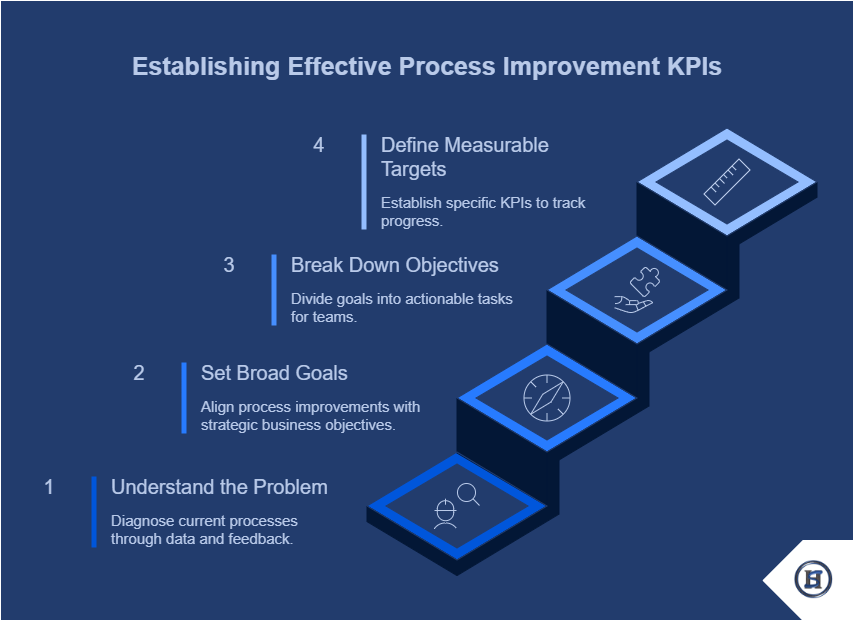Have you ever walked into a meeting where everyone agrees a process needs improvement, but no one knows how to measure progress? That’s where KPIs for Process Improvement come in. Without the right performance indicators, even the most well-intentioned initiatives can lose direction. In fact, over 70% of improvement efforts fail—not because teams lack effort, but because they track the wrong metrics or none at all. Aligning the right KPIs with clear goals can transform inefficiency into measurable success.
At Haile Solutions, we’ve helped businesses turn chaotic processes into streamlined operations that deliver real results. The secret? Using the right Key Performance Indicators (KPIs) to guide your journey.
Why KPIs Make or Break Your Process Improvement Efforts
Process improvement isn’t about making random changes and hoping for the best. It’s about making targeted adjustments that create measurable impact. Without clear KPIs, you’re essentially driving with your eyes closed.
When you track the right metrics, you can:
- See exactly where bottlenecks occur
- Measure the financial impact of improvements
- Build stronger cases for resource allocation
- Keep teams focused on what matters most
- Create a culture of continuous improvement
Let’s break down how to set up KPIs that actually work for your business.
Four Steps to Establishing Effective Process Improvement KPIs

Step 1: Understand the Problem
Before selecting KPIs, you need to diagnose what’s actually happening in your current processes.
How to do this effectively:
- Gather data from multiple sources, not just management reports
- Talk to frontline staff who work with the process daily
- Map the current process to identify handoffs and decision points
- Look for patterns in customer complaints or feedback
- Measure cycle times for different process stages
This investigative work helps ensure you’re solving real problems, not just symptoms.
Step 2: Set Broad Goals That Align With Business Objectives
Your process improvement efforts must connect directly to business outcomes that matter.
Ask yourself:
- How does this process affect customer satisfaction?
- What impact does it have on revenue or cost structures?
- Does improving this process help us meet strategic goals?
- Will changes make us more competitive in the marketplace?
- How will improvements affect employee experience?
This alignment ensures your work gets attention and support from leadership.
Step 3: Break Down Objectives Into Actionable Components
Once you have broad goals, break them into specific components that teams can act on.
For example, if your goal is “improve customer onboarding,” you might break this down into:
- Reduce documentation requirements
- Streamline approval workflows
- Improve communication during waiting periods
- Enhance training for onboarding staff
- Create better tracking systems for applications
Identify who owns each component and how it contributes to the larger goal.
Step 4: Define Specific, Measurable Targets
Now comes the critical part—selecting KPIs that tell you whether you’re making progress.
Effective process improvement KPIs often include:
| KPI Type | Metric | Description | Example |
| Efficiency | Cycle Time | Total time taken from the start to the completion of a process or task. | Time from order placement to delivery is reduced from 5 days to 3 days. |
| Process Velocity | Speed at which tasks move through workflow stages. | Tasks move through approval in 2 hours instead of 6. | |
| Resource Utilization | Measures how effectively resources (people, tools) are being used. | 85% of a developer’s time is spent on billable work. | |
| Error Rates | Frequency of mistakes or rework required in the process. | 2% of invoices require correction before client acceptance. | |
| Quality | First-Time-Right Percentage | Proportion of outputs done correctly on the first attempt. | 96% of project deliverables meet client expectations first time. |
| Compliance Rates | Degree to which outputs follow defined standards or regulations. | 100% of contracts meet internal compliance checklist. | |
| Customer Satisfaction (CSAT) | Measures how satisfied the customer is with the process outputs. | Average score of 4.5/5 for onboarding experience. | |
| Number of Exceptions | Counts how often the process must deviate from the standard. | 5 out of 100 orders required special manual handling. | |
| Financial | Cost per Transaction | Total cost to complete one transaction or process cycle. | $2.50 to process one invoice. |
| Revenue Impact of Improvements | Increase in revenue due to process changes or innovations. | $100K increase in revenue from faster client onboarding. | |
| ROI on Improvement Investments | Return generated from investing in process or technology improvements. | 150% ROI on automation software within 12 months. | |
| Savings from Reduced Waste/Rework | Money saved by minimizing inefficiencies or redoing tasks. | $25K saved annually by eliminating double data entry. |
10 Tips for KPI Tracking Success
Setting KPIs is just the beginning. Here’s how to make them work in practice:
- Creating clear accountability for acting on findings
- Building review cycles into team routines
- Connecting metrics to specific improvement hypotheses
- Tracking both leading and lagging indicators
Process Improvement Methodologies That Work With KPIs
Different approaches emphasize different types of measurement:
Lean focuses on eliminating waste and improving flow, with KPIs tracking:
- Value-added vs. non-value-added time
- Work in progress (WIP) levels
- Lead time and throughput
- Defect rates
Six Sigma uses statistical analysis to reduce variation, measuring:
- Process capability indices
- Defects per million opportunities (DPMO)
- Process sigma levels
- Cost of poor quality
Agile emphasizes iterative improvement with metrics like:
- Sprint velocity
- Cycle time
- Customer satisfaction
- Team happiness and engagement
The right approach depends on your organization’s culture, challenges, and goals.
Start Your KPI Journey Today
Implementing effective KPIs for process improvement isn’t about perfection—it’s about progress. Start with one process, select a few meaningful metrics, and build from there.
Remember that the goal isn’t measurement for its own sake. It’s about creating visibility that drives smart decisions and meaningful change.
If you are looking for “out-of-the-box” standard operating system (SOP) templates for your professional services business:
Ready to transform your processes with data-driven insights? Let’s talk about how we can help you identify the right KPIs for your specific challenges.
FAQ About KPIs for Process Improvement
A good KPI is directly connected to your business objectives, easily measurable, actionable, and understood by everyone involved. It should focus on outcomes that matter to customers and the business, not just internal activities. The best KPIs drive conversations about how to improve, not just whether you’re meeting targets.
While there’s no magic number, we recommend focusing on 5-7 key metrics for each process. Tracking too many creates data overload and dilutes focus. Choose a balanced set that covers efficiency, quality, and financial impact. You can always add more specialized metrics for deep dives into specific issues.
Different metrics have different natural rhythms. Operational metrics like cycle time might need daily or weekly review, while financial outcomes might be monthly. At Haile Solutions, we typically recommend a tiered approach: quick daily check-ins on critical metrics, weekly team reviews of trends, and monthly deep dives into overall progress and next steps.
We work with your teams to understand the processes most impacting your business success. Our consultants then help map current states, identify pain points, and establish baseline measurements. We collaborate with stakeholders to develop custom KPI frameworks that align with your specific goals and culture. Once implemented, we provide coaching on how to use these metrics to drive ongoing improvement.
This is a common challenge. We often start by setting up simple manual tracking to establish baselines while working on more robust data collection systems. Sometimes the most valuable initial KPI is “percentage of the process we can measure.” Imperfect data that drives conversation is better than no data at all, and measurement systems can improve alongside the processes they track.
True success goes beyond the KPIs themselves. Look for these signals: teams are using metrics in daily conversations, decisions are being made based on data rather than opinions, improvements are sustained over time rather than reverting to old patterns, and—most importantly—customers and employees are experiencing positive changes they can articulate.
- Automating data collection where possible
- Integrating measurement into existing workflows
- Starting small and expanding measurement as you go
- Eliminating metrics that don’t drive action






